Last updated on January 5, 2022
Content By: Dr. Nikita Toshi BDS, Assistant Manager (Medical Review) & Dr. Ritu Budania MBBS, MD (Pharmacology) Head, Medical Affairs
Last updated on January 5, 2022
We have often heard the saying, ‘Life is a rat race’ and to be honest, it is quite true. We all live a fast life and we often forget to take care of ourselves. But when you are diagnosed with diabetes mellitus, you have no option but to take a little time out from your busy schedule to try and keep the blood sugar levels in check. Living with diabetes is not something to be feared. Nowadays, we see many people around us dealing with it while leading close to a normal and healthy life.
But while we only think about the physical aspect of it, we often forget about our mental health. Exercise and maintaining good mental health plays an important role in controlling diabetes. And what better to help you achieve both than yoga! Yoga is a great form of exercise that focuses on strength, flexibility and core stability helping you burn calories while also helping you relax and get in tune with your body. Yoga has been recommended by many health professionals as an effective way to help manage diabetes and keep you safe from many other illnesses. Let’s look at some of the benefits of yoga and how it plays a role in lowering blood sugar levels in people with diabetes.
We have often heard the saying, ‘Life is a rat race’ and to be honest, it is quite true. We all live a fast life and we often forget to take care of ourselves. But when you are diagnosed with diabetes mellitus, you have no option but to take a little time out from your busy schedule to try and keep the blood sugar levels in check. Living with diabetes is not something to be feared. Nowadays, we see many people around us dealing with it while leading close to a normal and healthy life.
But while we only think about the physical aspect of it, we often forget about our mental health. Exercise and maintaining good mental health plays an important role in controlling diabetes. And what better to help you achieve both than yoga! Yoga is a great form of exercise that focuses on strength, flexibility and core stability helping you burn calories while also helping you relax and get in tune with your body. Yoga has been recommended by many health professionals as an effective way to help manage diabetes and keep you safe from many other illnesses. Let’s look at some of the benefits of yoga and how it plays a role in lowering blood sugar levels in people with diabetes.

Written by:
BDS, Assistant Manager (Medical Review)

Reviewed by:
MBBS, MD (Pharmacology) Head, Medical Affairs
Throughout the world, yoga has made itself known as one of the most versatile forms of exercise. It functions to improve your strength, flexibility, control and mental health, taking your well being forward with balance. Yoga has been the perfect way for newly diabetic patients to help take control of their health. With a range of exercises that incorporate absolutely fresh beginners and scaling up to the most seasoned practitioner, yoga is for everyone!

How is yoga helpful for diabetes?
For patients who are not used to exercising or working out, yoga control is a great place to start as there are many health benefits to practising yoga. As an exercise, it can help control blood sugar and increase insulin sensitivity in the cells. It is also easy to start since there are plenty of online courses and guides on yoga asanas for diabetes. In addition to helping to reduce blood sugar, yoga also promotes better blood circulation and relieves stress, which is a key contributing factor to the symptoms of diabetes.
So, is yoga good for diabetes? Yes! It is an exercise that impacts your health positively in many ways. Yoga helps with weight loss and reduction in stress levels. The benefits of daily meditation also improve mental health and determination, allowing you to more easily make the lifestyle changes you need to keep your diabetes under control.
Best Yoga Asanas for Diabetes Patients
How many yoga asanas are there to help manage diabetes? There are 84 recorded asanas and all of them play some part in improving your overall well-being and managing diabetes such as:
1) Surya Namaskar

Also known as the sun salutation, Surya Namaskar is one of the most comprehensive movement exercises in the world. What are the benefits of Surya Namaskar for diabetes? Doing this asana for 20 minutes elevates your heart rate and helps with weight loss, leading to lowered blood sugar and improved insulin sensitivity. It is one of the top 10 yoga poses for defeating diabetes because it improves the entire body in terms of strength and flexibility while improving blood circulation.
2) Viparita Karani
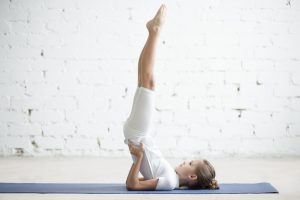
This is also called the legs-up-the-wall pose and is one of the most popular yoga asanas recommended for diabetes control. The reason being, it is simple, doesn’t require anything but a wall and provides the following benefits.
![]() Improved energy levels
Improved energy levels
![]() Relaxes the mind
Relaxes the mind
![]() Stretches the feet and legs, preventing cramps
Stretches the feet and legs, preventing cramps
![]() Improved lymph flow
Improved lymph flow
![]() Improved blood circulation
Improved blood circulation
![]() Aids digestion
Aids digestion
![]() Relieves back pain
Relieves back pain
Like Surya Namaskar for diabetes, this asana improves a person’s overall health and holistically controls the symptoms of diabetes by making it easier for a person to manage their blood sugar.
3) Halasana
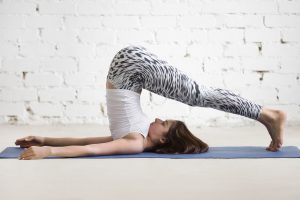
Halasana or the plow pose works multiple muscle groups in the body. The exercise strengthens your shoulders, hamstrings and spine.
If you feel unable to do this asana right away, start with the supported shoulder stand, also known as Salamba Sarvangasana. Once you are able to maintain balance with the shoulder stand, you can gradually work on doing the full Halasana.
4) Ardha Matsyendrasana

This sitting posture is also called the sitting half spinal twist or the lord of the half-fish pose. It is a fairly simple asana but requires you to push yourself just a little bit. This asana works your spine, chest and hip, improving the strength and flexibility of these muscles. This pose can stimulate the organs in the abdomen and facilitate lowered blood sugar. An added benefit of this is that it can improve your digestion as well.
5) Shavasan or Savasana
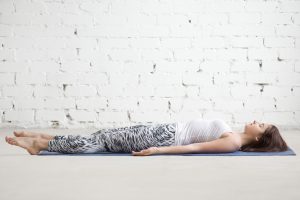
This asana is also called the corpse pose and is a practice of resting within your yoga practice. The asana emphasises rest and releases your body from the effects of stress, making it one of the top 10 yoga poses for defeating diabetes. The practice of stillness from the shavasan pose helps reduce the tension and stress that normally builds up during a workout.
Yoga and Mindful Eating
We are already aware that to keep our diabetes in check we have to take care of our body with proper food and exercise. And even if you are not ready to go hit the gym, you can always opt for yoga. Yoga not only helps you keep your body weight in check but also helps with your mental stability and peace. It has also been seen that yoga also pushes us to make some positive changes to our lifestyle like changing what we eat. Mindful eating doesn’t mean you are starving yourself. Rather it means that you are aware of what kind of food will help you control diabetes and when you should stop eating. One should stay away from all distractions while eating. Eating every bite of your meal with a feeling of positivity and gratitude has a great role to play according to Ayurveda.
What Is The Best Time To Do Yoga For Diabetes?
The best time for yoga and meditation is in the morning before breakfast. There’s a reason it is called a Surya Namaskar, you are greeting the sun at the start of the day. You will benefit the rest of the day with improved energy levels and a better state of mind.
While there are many health benefits of morning yoga practice, if you find it difficult to wake up early or make time in the morning, then the evening is fine. After a full day of activity, the body has optimized a number of its functions and you can exercise at a higher level.
Choose a time where you will not be disturbed and can focus on your exercise. It is more important to be consistent than to try and catch the best time. for yoga and meditation.
How Frequently Should One Do Yoga For Diabetes?
It is recommended that diabetics get 150 minutes of diabetes exercise a week. Calculate the time for each yoga session based on the yoga asanas for a diabetes cure that benefit you the most.
Around 4 – 5 sessions of yoga every week will give you the rest days you need in order to recover from any soreness you may develop. However, you should not miss yoga sessions 2 days in a row. Consistency is key, so be regular and get the most from each session.

Diagnosed with diabetes?
Explore diabetic care products on PharmEasy to help you on your journey to recovery
The Surya Namaskar is an ancient practice handed down from teacher to student as a dedication to the Sun God, Surya. Historically, the sequence became popular in the 20th century when Bhawanao Shriniwasrao Pant Pratinidhi wrote a book titled “The ten-point way to health: Surya Namaskars” written in 1928. It wasn’t considered yoga until Krishnamacharya incorporated it into his own yoga style in Mysore, where the Ashtanga yoga style originated.
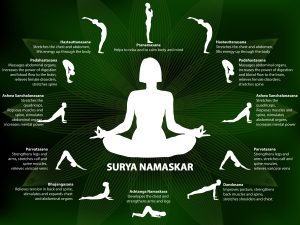
As shown in the image, the steps of Surya Namaskar are:
#1 Pranamasana – Prayer Pose
Place your feet together at the edge of your mat, expand your chest and relax your shoulders. While inhaling, bring your arms up from your sides and then while exhaling, join your palms together in front of your chest.
#2 Hasta Uttanasana – Raised Arms Pose
From the prayer pose in step 1, raise your arms and stretch backwards while inhaling, such that your ears and biceps are next to each other. Stretch from the tips of the fingers to the heel but make sure to keep your balance and control your breathing. Push your fingers upward rather than just stretching them backwards.
#3 Hastapadasana – Forward Standing Bend
From the raised arms pose, while exhaling, bring your arms forward while maintaining the stretch and bend at the waist. By the time you finish exhaling, bring your hands down next to your feet. If done correctly, this position ends with your face opposite to your knees.
#4 Ashwa Sanchalanasana – Equestrian Pose
While breathing in, take your right leg as far back as possible without losing balance and look upwards as you let your knee touch the floor in full stretch. The left foot should be in line with both your palms.
#5 Dandasana – Stick Pose
Continue from the previous step and while breathing in slowly, bring your left leg back so you are in a plank position and keep your whole body in a straight line. Keep your arms straight while you are in this position.
#6 Ashtanga Namaskara – 8 Point Salute
Bring your knees down to the floor and begin to exhale. While doing so, push your hips backwards, rest your chin and chest on the floor. When you have your two feet, two knees, chest and chin on the floor with your hips in the air, you are doing the 8 point salute successfully.
#7 Bhujangasana – Cobra Pose
From the Ashtanga Namaskara, while inhaling, slide forward so your lower body is on the floor and raise your upper body with your arms beside you. Your elbows will be bent and your head should be looking upwards.
#8 Adho Mukha Svanasana – Downward facing dog
Keep your hands where they are and as you breathe out, lift your hips and bring yourself into an inverted V posture. Make sure your heels are on the floor and the neck is in line with the back with the arms in full stretch.
#9 Ashwa Sanchalanasana – Equestrian Pose
Inhale slowly and from the inverted V posture, bring your right foot forward and raise your head. The right foot should be in line with your palms while your left knee and foot are touching the floor at full stretch.
#10 Hastapadasana – Standing Forward Bend
Bring your left foot forward while exhaling and keeping your palms on the floor. Both your feet and palms should be in line. The final posture is the same as the one in step 3 but it is done in reverse.
#11 Hasta Uttanasana – Raised Arms Pose
Breathe in, arch your back and raise your arms upwards while keeping your shoulders straight such that your arms look like they are reaching backwards. You should reach the same posture as the one in step 2.
#12 Tadasana – Mountain Pose
Finally, bring your arms back to your side and straighten your back as you exhale and you will be in the position you started in. Now the 12 step sequence is complete. Make sure to breathe correctly as far as possible and do not push yourself too hard. It will become easier to do all 12 steps of Surya Namaskar yoga fluently as you keep practising.
What are the benefits of Surya Namaskar?
The exercise tones your muscles and works the entire body. It also elevates your heart rate when the breathing control is correctly executed. You will find yourself working up quite a sweat after 5 – 10 minutes of doing Surya Namaskar.
When should Surya Namaskar be done?
The exercise itself was made to be done in the morning, as a dedication to the sun and doing it in the morning will give you better energy levels and well being throughout the day. It is considered to be one of the best yoga asanas for diabetes cure or reversal.
Supportive Asanas to Perform With Surya Namaskar
You can take up the individual steps of the Surya Namaskar and practice them until you are comfortable. When you are able to do the individual steps fluently, you can slowly start to combine them in the correct sequence. You can incorporate Ardha Matsyendrasana and Savasana with the Surya Namaskar steps to help you stretch and rest.
Here are more asanas that you can perform along with Surya Namaskar:
Agnisar kriya – This asana is a cleansing technique that is believed to clear the maipura or navel chakra and improves digestion by strengthening the muscles in the abdomen. You pull back your abdomen and then snap it backwards and forward while holding your breath.
Vaman dhauti – This asana targets the systemic cleaning of the alimentary canal with induced vomiting. This asana increases glucose uptake and minimises insulin resistance in our bodies. So if you have high blood sugar, it is really helpful.
Uddiyan bandha – This classical bandha asana not only helps tone abdominal muscles but also helps control breathing and energize the body. Here you stand on the mat and bend forwards while placing your hands on your knees. Now take a deep breath and forcefully exhale till your lungs are almost empty. Hold it for around 10 – 15 secs and breathe again.

Explore a range of diabetics care products on PharmEasy to
help you keep your sugar levels in check from home!
What is pranayama in yoga?
Pranayama is the practice of regulating your breathing with different breathing patterns and exercises. Many are the health benefits of pranayama as it works along with the benefits of yoga asanas and meditation to boost lung function and mental health. So if you’re wondering which yoga is best for diabetes, it is the type that incorporates asanas with pranayama and meditation. Now let’s look at the types of pranayama used in yoga.
Types of Pranayama Exercises Used in Yoga for Diabetes
1. Anulom Vilom

This is a controlled breathing technique where you hold one nostril shut while inhaling and close the other nostril while exhaling, after which you switch over and repeat. Also known as alternate nostril breathing, it is linked with benefits to mental health and improvement in the respiratory system.
2. Dirgha – The three-part breath
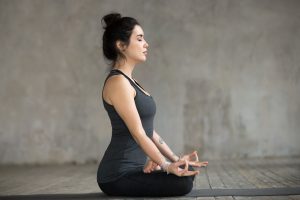
Also known as the complete breath, this is a deep breathing exercise that can be done when you are seated or lying down.
Step 1 – Place one palm on your belly and one palm on your chest and gently exhale till there is no air left in your lungs.
Step 2 – Once the lungs are empty, inhale into your belly till it is full and then into your chest.
Step 3 – On the exhalation, release from your diaphragm and then your belly.
Step 4 – Once you are done exhaling fully, it is time to inhale in three parts, into the belly, into the chest and once more into the chest.
The reason you keep your hands on your belly and chest is to feel the inflow of air and control it such that you breathe into the area you are aiming for. The third breath is taken into the upper chest and you will exhale it in the reverse order, upper chest, chest and finally the belly.
3. Shitali

This is one of the many breathing exercises that your body will love. Shitali specifically focuses on cooling the body. It is said to purify the blood and have a rejuvenating effect.
Step 1 – Sit in a cross-legged position or lotus position, relax and close your eyes.
Step 2 – Breathe deeply a few times to prepare.
Step 3 – Stick your tongue out as far as possible but not till it hurts. Now using your lips, try to make an O shape with your tongue by folding it together like a sandwich.
Step 4 – Inhale slowly and smoothly, you will feel a coolness while you do this.
Step 5 – Draw the tongue in and exhale through the nose.
Step 6 – Aim to repeat the process 15 times and try to increase the duration of each breath as you keep practising.
4. Ujjayi Bhramari

This is a meditative breathing exercise that involves a yoga mudra or hand position. Sit straight, place your palms facing upwards on your thighs with your elbows stuck to your torso. To make this yoga mudra for diabetes, with your favoured hand, press the tip of your index finger with the tip of your thumb to create a circle and keep the remaining fingers straight.
This yoga mudra for diabetes is mixed with the alternate nostril breathing technique Anulom Vilom. You close the nostrils with your thumb and index finger alternatively. There are six breathing forms to this exercise.
Form 1 – Breathe quickly with both nostrils.
Form 2 – Close your right nostril, quickly inhale and exhale through the left nostril.
Form 3 – Close your left nostril, quickly inhale and exhale through the right nostril.
Form 4 – Close your right nostril, inhale, open your right nostril, close your left nostril and exhale.
Form 5 – Close your left nostril, inhale, open your left nostril, close your right nostril and exhale.
Form 6 – Type 4 breathing followed by type 5.
You can increase the speed of breathing as you get better at it. Aim to practise Ujjayi Bhramari Pranayama for 2 – 5 minutes every day when you do yoga.
5. Bhastrika
This pranayama technique facilitates better blood flow by giving the heart a signal to pump blood more rapidly.
Step 1 – Sit down in a cross-legged position or on your knees and relax.
Step 2 – Make fists with both your hands and place them next to your shoulders.
Step 3 – Take a deep breath, raise your hands and open them.
Step 4 – Exhale with force and bring your hands back down to your shoulders and close them.
Step 5 – Repeat it 20 times.
Step 6 – Place your palms on your thighs and relax. Repeat for two more sets.
6. Kapalbhati
Literally translated into “Shining Forehead”, is an exercise that aims to improve your intellect and cleanses your mind.
Step 1 – Sit down with an erect spine with palms facing upwards on your thighs.
Step 2 – Breathe deeply and as you exhale, draw your navel inwards to your spine as far as possible. It helps to have a hand on your abdomen to feel the movement.
Step 3 – Relax the pull on your navel and the breath will flow into your lungs on its own.
Step 4 – One round of Kapal Bhati is complete after 20 such breaths.
Step 5 – After finishing one round, take some time to observe what you are feeling.
Step 6 – Follow up with two more rounds to conclude a full session.
7. Sheetkari
The hissing breath, Sheetkari, is a cooling breath technique similar to Shitali.
Step 1 – Press your tongue against the roof of your mouth and take controlled, deep breaths through your mouth into the abdomen, chest and upper chest similar to the three-part breath.
Step 2 – The inhalation through the teeth will produce a sharp hissing sound.
Step 3 – Extend your neck and lock your chin against your chest while holding your breath.
Step 4 – Once you start to feel discomfort, stop the chin lock and exhale through your nose.
Step 5 – Aim to do 15 of these breaths but avoid doing them when it is cold or if you are feeling unwell.
Mudras for diabetes and weight loss
Yoga has been practised for centuries in ancient cultures. It is something that has been born of years of studies and research and is a symbol of peace of mind and wellness of the body. Mudras are a part of yoga asanas and are hand gestures that help activate the flow of energy in the body.
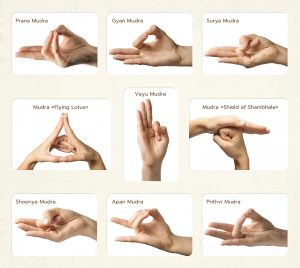
Let us look at a few mudras that help us with diabetes and weight loss:
Surya Agni mudra – This mudra helps activate the fire energy in the body and helps with digestion and metabolism if performed regularly. Digestive issues can lead to unhealthy lifestyles, so this mudra aids in controlling your weight and your blood sugar levels as well.
Kapha-Nashak Mudra – This mudra is formed by placing the thumb over the ring fingers and little fingers in both hands and applying pressure. Half an hour of this mudra helps you control your digestion and also helps in weight loss as it facilitates metabolism.
Linga mudra – Also known as Lord Shiva’s mudra, the linga mudra is believed to have been practised by gods in ancient times. The mudra symbolises the victory of positivity over negativity in the body and this helps flush out toxins and revitalize organs. Linga mudra helps in weight loss and controls your blood pressure and sugar levels by improving the body’s metabolism.
Vaayan mudra – This mudra is associated with the element air. You bend your index finger towards the palm and press with your thumb for 15 – 20 minutes. If practised daily, this helps improve your nervous system and helps you become more aware of your body.
Gyan mudra – This as the name suggests is a mudra of knowledge. This mudra when practised along with breathing exercises, helps reduce stress and you find it easier to fall asleep. Proper sleep and rest ensure that you can control your weight and blood sugar.
What are the benefits of pranayama in yoga for diabetes?
There are several benefits of pranayama for people with diabetes. Performing pranayama correctly:
Reduces stress – In our hectic daily life, it is impossible to live a life without stress. But pranayama helps you align the mind and body and if practised daily helps reduce stress.
Improves sleep – Not getting the appropriate hours of sleep is a major reason why one gains weight. But if you can relieve stress in life, it will allow you to rest and help maintain your weight and also your diabetes in the long run.
Improves mental health and mindfulness – Pranayama is one of the best relaxation techniques to calm your mind along with your body.
Helps manage high blood pressure – Obesity leads to both diabetes and high blood pressure. So if you are being active with yoga every day your weight will be in check and your blood pressure will be in control too.
Enhances lung function – If you perform yoga properly every day, it will also improve your lung function. The basis of yoga is healthy breathing exercises and it helps keep your lungs healthy.
Improves cognitive function – Practising yoga has been shown to help cognitive functions like attention, processing speed, memory and even impulse control.
Basic Do’s and Don’ts of Pranayam
| DOs | DON’TS |
|---|---|
| Take your time to learn how to do it accurately and gradually increase the amount of time and repetitions to reap the full benefits of pranayama. | Don’t do Pranayam when you are coming down with a cough or cold. |
| Maintain a rhythm when you are practising pranayama. Some people like using soft, non-intrusive music or a slow metronome. | Do not push yourself if you feel any pain or discomfort. Don’t do pranayama outdoors if the weather is cold. |
| If you’ve had any injuries, heart disease, hypertension or blood pressure-related diseases, please consult a doctor and yoga expert before trying anything new. | Avoid doing pranayama after meals, give at least a 3 hours gap. |

Skip the long queues at the store!
buy prescription medicines on PharmEasy and get it home delivered in an instant.
Mental stress can impact blood glucose levels, which means that managing your stress is a way of controlling your blood sugar. Meditation benefits your physical body as well as reduces stress and improves your mental stability, allowing you to deal with your fears and anxieties and pressures of life better.

Diabetes is a condition that requires a certain amount of discipline to manage. Without making good lifestyle choices, diabetes can go from being an inconvenience to a serious problem. If you are struggling with your mental health, set aside some time every day – it can be even 5 – 10 minutes to focus on self-care and rejuvenation. Here are a few things you can do in that time:
Meditate
Take this time to close your eyes and tune in to your breathing. As you breathe in, focus on filling your lungs with as much air as possible. When you exhale, imagine that you’re breathing out toxins, worries, fears and stresses of this world out of your body. In the stillness, try to lay down any distractions and become aware of your senses, the sounds you can hear, the wind on your skin, your heartbeat, etc.
Journal
Journaling is a great way to help declutter the thoughts of your mind and put them down on paper. While there is no strict way to journal, here are a few things you can try:
A hobby you love
In the 5 – 10 minutes or how much ever time you have, spend time on that hobby or extracurricular activity you love doing. It can be playing an instrument or reading your favourite novel, listening to music or a podcast, singing karaoke, or even painting on a canvas.
Taking time to prioritize your mental health especially when you are dealing with diabetes can go a long way in your journey to recovery. Practices like these can moreover create a stronger drive to achieving your health goals.
Benefits of daily meditation for 30 minutes
Lowers blood pressure – Stress is one of the biggest contributors to high blood pressure. Researchers studying the link between stress and high blood pressure have noted a significantly lowered blood pressure among people who meditate regularly and maintain better mental health.
Boosts concentration ability and the power to retain information – Meditation for the brain is like exercise for the body. Studies have found that people who meditate have longer attention spans and retain more information than people who don’t have some form of mental exercise.
Helps in getting a peaceful sleep – Meditation calms the mind and helps you deal with mental noise. This is a gamechanger for people who do not get enough sleep because of how long it takes them to fall asleep.
Calms the mind from anxiety, stress and symptoms of depression – Depression has become more common today than ever and one of the most commonly recommended home remedies for it is meditation and mindfulness. Meditation improves self-awareness and emotional health, allowing people to analyze themselves and have better reactions to the things that cause anxiety, stress and other symptoms of depression.
Eases physical pain – For people with chronic pain that always lingers, meditation can be a useful tool that allows them to focus on other things. Pain is also compounded by stress, which can be reduced and controlled through meditation. Studies have shown that meditators are better at coping with pain and may even experience reduced pain compared to non-meditators.
Best methods to meditate if you are diagnosed with diabetes
There are many different types of meditation that can help you along with yoga.
Mindfulness meditation
In this form of meditation, you are an observer viewing your thoughts and making note of patterns, leading to a greater understanding and therefore control of your mind.
Spiritual meditation
Often done using essential oils and incense to heighten the feelings of spirituality, spiritual meditation is a way of seeking a deeper connection with the universe or God, as you understand and believe in him.
Mantra meditation
This type of meditation uses a repetitive sound or chant, like “Om” to keep the meditator rooted to their awareness. Sometimes people prefer this over focussing on their breathing since it is simpler and involves them a little more actively.
Progressive muscle relaxation
This is a more physical approach to meditation that involves feeling the way different muscle groups in your body stretch and relax. It is an especially popular form of meditation for people to destress before they go to bed.
Metta/love & kindness meditation
The idea behind this meditation is to improve your connection with other people and enhance feelings of love, acceptance and compassion. It is used as a form of therapy for people who harbour resentment or anger for each other.
Simple Meditation Tips for Beginners
If you are new to meditation, there are certain tips to keep in mind:

Experiencing diabetes symptoms?
Book a test with Pharmeasy today in just a click!
Is yoga good for diabetes patients?
Yoga helps with weight loss, blood circulation, increases insulin sensitivity and reduces stress. Yoga can help patients maintain an optimal weight and combat insulin resistance.
Does yoga help to balance blood sugar levels permanently?
By its very nature blood sugar has continuously fluctuating levels. It is unlikely that you can permanently keep balanced blood sugar levels even if you eat the same thing every day and exercise the same amount. Yoga helps balance the blood sugar on a day to day basis but can diabetes be cured permanently by Yoga? Unfortunately, no.
Can meditation help with diabetes?
Meditation for diabetes addresses some of the contributing factors to diabetes, like stress, anxiety and poor sleep habits. It also helps in keeping you motivated towards a healthier lifestyle.
When is the best time to do yoga or meditation for diabetes?
Doing yoga is best in the morning on an empty stomach. You burn more calories and finish your workout without interruption, giving you the benefits of the exercise throughout the day. Try out different types of meditation anytime and find out what works best for you.
Can diabetes be cured permanently by yoga?
Type 2 diabetes cannot be cured. However, it is possible to manage diabetes with sufficient weight loss, exercise, medications and a good diabetes diet plan. This does not mean it is cured, just that the person can keep their blood sugar in check without any medication in some cases.
If I don't like yoga, is it ok to do other forms of exercise?
It is okay to do any kind of exercise so long as you can consistently do it and it helps you control your diabetes. Yoga is not a must for diabetes type 1 or 2 and you can get your exercise in a way that appeals to you.
Is it necessary to do exercise daily?
It is recommended that every diabetic gets at least 150 minutes of exercise a week to help keep their blood sugar levels in check. 3 – 5 days a week is sufficient based on the length of each session but daily exercise is a great habit to have.


Leave a Comment